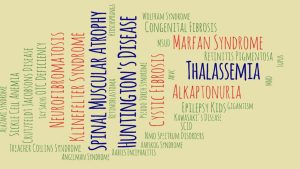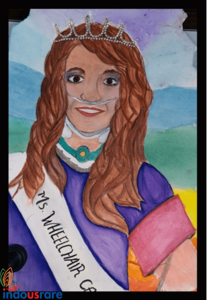A survey of rare disease awareness among healthcare professionals and researchers in India
Posted on: 12 May 2023
Preprint posted on 2 April 2023
Survey identifies opportunities to improve RD awareness and knowledge among healthcare professionals and researchers in India.
Selected by Preethi KrishnarajCategories: scientific communication and education
Background
The term ‘rare disease’ (RD), which affects only a few people, does not have a universally accepted definition. Instead, RDs are defined based on an individual country’s political and legislative framework. Though RDs are of low prevalence, taken together they affect around 400 million people globally. Often diagnosing an RD may take up to 4-7 years1, (by then the disease has already progressed) and sometimes the disease is misdiagnosed. It is estimated that 7000 RDs exist globally, though this number is likely to be an underestimation.

Figure adapted from this preprint: This word cloud represents different rare diseases mentioned by respondents of the survey in this preprint.
These ~7000 RDs are diverse in their genetic and clinical characteristics, but there are several commonalities that the patients and families affected by RDs experience in their diagnostic odyssey, treatments, financial burden and emotional impact2.
In this preprint, the authors have conducted an exploratory survey of the Indian population with the goal of understanding the extent of RD awareness among health care professionals (HCP) and researchers. The findings from this survey can help develop several hypotheses for future works.
Methodology
The survey was designed to include questionnaires for HCPs and researchers. The authors reached out to representative groups including physicians, nurses, genetic counsellors, or researchers in biomedical sciences. There were a total of 117 respondents which included 52 HCPs and 65 researchers. The questions were framed based on: awareness and diagnosis of RDs, genetic testing and prevention, treatment options, molecular basis of the RD and resources for RD information.
Findings of this preprint
The overall level of awareness of RDs
From the survey it is evident that there is much room for improving awareness levels among both HCPs and researchers, particularly in terms of the definition, diagnosis, treatment, and prevalence of RDs. One particularly important finding for RD-related educators is that, although the respondents recognised many RDs, some of the diseases mentioned by them are thought not to be rare in some parts of India due to their high prevalence. In addition, most respondents did not know whether RDs could have an association with a particular geographic region, which suggests a lack of understanding of the RD epidemiology. Hence, the authors propose awareness campaigns and trainings for HCPs which focus on educating them in RD prevalence, identification, screening, therapies (if available), and other interventional measures that can be taken up by the patients or their families.
Researchers and patient organisations of today and the future
This preprint highlights that both HCPs and researchers acknowledge the role that research papers, in addition to social media and print media, play in educating themselves. The preprint also emphasises the need for better collaborations between researchers and HCPs to improve the understanding and management of RDs in India. Additionally, research on indigenous RDs needs more encouragement and support.
Patient organizations in India have contributed significantly to driving RD policy and creating awareness among the general public. The authors further suggest that the medical and research communities should acknowledge the importance of patient advocates in raising awareness and involve them more formally in developing modules for medical education3. Along the same lines, the authors point out that medical students should be encouraged to volunteer with RD organisations so that they will be more informed about the challenges faced by the RD community.
Why I like this preprint
This preprint, being the latest survey conducted in India, sheds awareness on the current state of knowledge on RDs among HCPs and researchers. This study can be important in highlighting the need for more research and awareness-raising efforts, which will in turn encourage healthcare policies and new reforms. In addition, although this preprint represents the Indian scenario, it is evident from several RD communities that a similar situation exists globally and that more awareness of RDs are needed among a wide range audience.
Concluding remarks from the preLighter
Every year on the 28th of February, people around the world celebrate Rare Disease Day (RDD). I had the privilege of attending a RDD event, and it was truly inspiring to witness how those living with RDs could embrace life with confidence, “living rare with confidence”. Despite the challenges they face, the RD patients are resilient and determined to live life to the fullest. With continued scientific advancements and support for RD patients, it will be exciting to see how much more the they will be able to achieve.
“Living rare with confidence”

A self portrait of Miss. Wheelchair California, Deborah Vick, Image from Art4Rare, IndoUSrare.org
To conclude: ‘raising awareness’ on RDs does not only mean increasing knowledge of RD among the general public, but also ensuring that RD issues are prioritized on the calendars of researchers, clinicians, policy makers, and world leaders. These community-based surveys, if conducted periodically, could help in understanding the nation’s level of education and can bring important new insights for the future.
Questions to the authors
- Given that the majority of RDs have a genetic origin, what further research could be put forward by the next generation researchers in India?
- Has the number of RD cases increased or decreased over the last decade? What has become the main reason(s) in India (and globally) for this trend in numbers?
References
- Isono, M., Kokado, M. & Kato, K. Why does it take so long for rare disease patients to get an accurate diagnosis?-A qualitative investigation of patient experiences of hereditary angioedema. PLoS One 17, 1–17 (2022).
- Rajasimha, H. K. et al. Organization for rare diseases India (ORDI) – addressing the challenges and opportunities for the Indian rare diseases’ community. Genet. Res. (Camb). 96, e009 (2014).
- Choudhury, M. C. & Saberwal, G. The role of patient organizations in the rare disease ecosystem in India: An interview based study. Orphanet J. Rare Dis. 14, 1–14 (2019).
Further references and useful info
- https://rarediseases.org/
- https://rarediseases.info.nih.gov/
- https://ordindia.in/about-rd/rare-disease-in-india/
doi: https://doi.org/10.1242/prelights.34649
Read preprintSign up to customise the site to your preferences and to receive alerts
Register hereAlso in the scientific communication and education category:
Have AI-Generated Texts from LLM Infiltrated the Realm of Scientific Writing? A Large-Scale Analysis of Preprint Platforms
Amy Manson et al.
Sci-comm “behind the scenes”: Gendered narratives of scientific outreach activities in the life sciences
Martin Estermann et al.
An analysis of the effects of sharing research data, code, and preprints on citations
Reinier Prosee et al.











 (No Ratings Yet)
(No Ratings Yet)